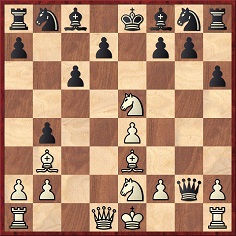
Edward Winter
The main focus of the present article is a selection of little-known specimens of the queen sacrifice which have appeared in Chess Notes.
***
In this game White undertook to mate his opponent in, at most, 35 moves:
Charles Gilbert Marriott Watson – N.N.
Melbourne, 1916
Danish Gambit
1 e4 e5 2 d4 exd4 3 c3 dxc3 4 Bc4 c6 5 Nxc3 b5 6 Bb3 b4 7 Nce2 Qf6 8 Nf3 h6 9 Be3 Qg6 10 Ne5 Qxg2

11 Qd4 Qxh1+ 12 Kd2 Qxa1 13 Bxf7+ Kd8 14 Nf4 c5 15 Ne6+ Ke7 16 Qd5 Qxb2+ 17 Ke1 d6 18 f4 Nf6 (Suicide.) 19 Qxd6+ Kxd6 20 Bxc5 mate.
Source: The Times Literary Supplement, 21 December 1916, page 628.
(BCM, 1975)
‘One of the most beautiful games played in Spain’ is Morán’s description in Campeones y Campeonatos de España de Ajedrez (Madrid 1974) of a fine brevity from the Torneo Nacional de Valencia, 2-9 October 1932. (The event was designed to find a challenger to Dr Rey Ardid’s title but, curiously, was based on a programme of two games to be played per day. The winner was Jaime Casa (1902-68), who went on to a decisive defeat by Rey Ardid the following year by five games to one.) But the brilliancy of the 1932 tournament was the game between Dr Ramón Tramoyeres and Valentín Marín, a miniature with a nice crisp finish:
1 e4 e6 2 d4 d5 3 Nc3 Bb4 4 Nge2 dxe4 5 a3 Bxc3+ 6 Nxc3 f5 7 Bf4 Nf6 8 f3 exf3 9 Qxf3 O-O 10 O-O-O Nd5 11 Bc4 c6 12 Rde1 Nxf4 13 Qxf4 Rf6 14 g4 fxg4 15 Qxg4 Rg6 16 Qh3 Qg5+ 17 Kb1 Rh6
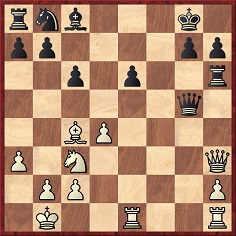
18 Rhf1 Rxh3 19 Rxe6 h6 20 Rxh6+ Qd5 21 Nxd5 gxh6 22 Ne7+ Resigns. Morán gives the pleasant line 22...Kh8 23 Rf8+ Kg7 24 Rf7+ Kh8 25 Ng6+ Kg8 26 Rd7 mate.
(80)
However, no mention is made of 21...Rxh6, after which White still has to overcome stiff resistance in the endgame.
C.N. 272 asked: which is the oldest surviving game that contains a queen sacrifice?
In C.N. 319 the reply of Kenneth Whyld (Caistor, England) was quoted:
‘A tricky question because the definitions of “game” and “sacrifice” are both debatable. The two positions below are allegedly from games, and in both games (?) the “sacrifice” gives instant mate:
N.N.-Greco, about 1620
12...Qg1+ 13 Nxg1 Nf2 mate.
N.N.-Severino, about 1723
10...Nxe5 11 Bxd7 Nxf3+ 12 Kf1 Bd3+ 13 Qxd3 Re1 mate.
However, I go for Brühl v Cotter, 1788 (BC5 on page 11 of the Oxford Encyclopedia of Chess Games), where the queen is given up for material of less value about 35 moves before the end of the game.
[14...Bd8 15 e5 dxe5 16 Bh7+ Nxh7 17 Rxd7 Bxd7 18 fxe5 Rxe5 19 Nd5 Rg5, and the game was drawn at move 51.]
An interesting game.’
Indeed it is, and one to show to anyone foolish enough to repeat the old claim that nobody could develop pieces properly in the opening before the arrival of Morphy.
(319)
Another familiar game-score (N.N.-Greco, circa 1620): 1 e4 e5 2 Nf3 Nc6 3 Bc4 Bc5 4 O-O Nf6 5 Re1 O-O 6 c3 Re8 7 d4 exd4 8 e5 Ng4 9 Bg5 Nxf2 10 Qb3 dxc3 11 Bxd8 cxb2 12 Nc3 Nd1+ 13 Kf1 bxa1(Q) 14 Rxd1 Qxd1+ 15 Nxd1 Nxd8 (Black wins).
Addition on 2 October 2023:
Richard Forster (Winterthur, Switzerland) sends us an extract from H.J.R. Murray’s manuscript concerning the Brühl v Cotter game, which Murray copied from the Atwood manuscript (the context and references being explained on page 865 of Murray’s A History of Chess):

Two entertaining games caught our eye in issue 170 of SSKK Bulletinen (4/1982). SSKK, as every schoolboy knows, stands for Sveriges Schackförbunds Korrespondensschackkommitté.
Yngve Seger – Harry Andersson
Oldboys-SM, 1962 (Final)
Sicilian Defence
1 e4 c5 2 Nf3 d6 3 d4 cxd4 4 Nxd4 Nf6 5 Nc3 a6 6 Bc4 g6 7 f4 e6 8 O-O Bg7 9 f5 b5 10 Bb3 e5 11 Nf3 gxf5 12 Ng5 Qb6+ 13 Kh1 Ra7 14 exf5 Rd7 15 Ne6 Rg8 16 Bg5 Bb7 17 Bxf6 Bxf6 18 Bd5 b4 19 Ne4 Ke7 20 Nxf6 Kxf6
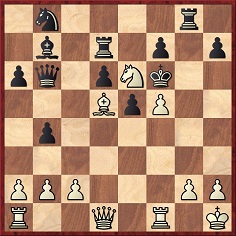
21 Qh5 fxe6 22 fxe6+ Kg7 23 Qg5+ Kh8 24 Qxg8+ Kxg8 25 e7+ and Black resigned, just in time to keep the game a miniature. [Regarding this remark of ours, see the comments in C.N. 471 by W.H. Cozens.]
The second game has an unusual queen sacrifice which exploits White’s neglect of proper development.
Bo Wiker – Kenth Sandéhn
Lag-SM, 1982
French Defence
1 e4 e6 2 d4 d5 3 Nc3 Bb4 4 e5 c5 5 a3 Bxc3+ 6 bxc3 Ne7 7 Qg4 O-O 8 Bd3 c4 9 Be2 Qa5 10 Bd2 Nbc6 11 Nh3 f6 12 f4 Bd7 13 Rf1 b5 14 Rf3 Qa4 15 Bd1 b4 16 exf6 Rxf6 17 Ng5 h6 18 Rh3
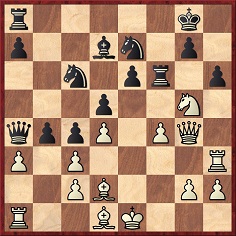
18...Qxa3 19 Rb1 Qa2 20 Rxb4 Nxb4 21 cxb4 Raf8 22 Nf3 c3 23 Be3 Nf5 24 Bf2 Qb2 25 Ne5 Bb5 26 Qf3 Nxd4 27 Bxd4 Rxf4 28 Qxc3 Rf1+ 29 Kd2 Rxd1+ 30 Kxd1 Rf1+ 31 White resigns.
(282)
The SSKK Bulletinen continues to offer plenty of fine chess. From issue 171 (5/1982) we pick this game:
Novosibirsk – Saratov
‘Telegraph Match, 1960’
King’s Indian Defence
1 d4 Nf6 2 c4 g6 3 Nc3 Bg7 4 e4 d6 5 f3 O-O 6 Nge2 Nbd7 7 Be3 e5 8 Qd2 c6 9 d5 cxd5 10 cxd5 a6 11 O-O-O b5 12 Kb1 Nb6 13 Nc1 b4
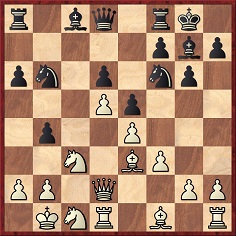
(297)
H. von Ehlert – P. Bohl
Riga Tournament (Brilliancy Prize), 1901
Ruy López
1 e4 e5 2 Nf3 Nc6 3 Bb5 a6 4 Ba4 Nf6 5 d4 exd4 6 O-O Be7 7 e5 Ne4 8 Nxd4 Nc5 9 Nf5 h5 10 Nxg7+ Kf8 11 Nxh5 Nxe5 12 Nc3 d6 13 h3 Nxa4 14 Nxa4 Bxh3 15 Nf4 Bg4 16 f3 Bd7 17 Nc3 Bh4 18 Ne4 Bb5 19 Ne2 d5 20 N4c3 Qd6 21 Nxb5 axb5 22 Bf4 Ra4 23 Be3 Ng4 24 fxg4
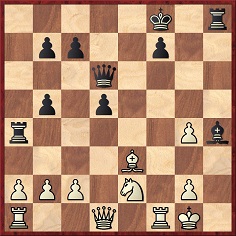
Source: Wiener Schachzeitung, October-November 1907, page 337-338.
(352)
A game contributed by W.H. Cozens (Ilminster, England):
Robert Grau – Alejandro Guerra Boneo
Argentine National Tournament, Buenos Aires, 1921
Vienna Game
1 e4 e5 2 Nc3 Nf6 3 Bc4 Bc5 4 d3 d6 5 f4 Nc6 6 f5 Na5 7 Bg5 Nxc4 8 dxc4 c6 9 Qd3 a6 10 Nf3 b5 11 O-O-O Qb6 12 h3 Rb8 13 cxb5 axb5 14 Bxf6 gxf6 15 Nd2 Ke7 16 Nb3 Ra8 17 Nxc5 Qxc5 18 Rd2 b4 19 Nb1 Rxa2 20 Rhd1 Rd8 21 g4 h6 22 h4 Ra1 23 g5 Qa5 24 gxf6+ Kxf6 25 Qe3 Qa2 26 Qxh6+ Ke7 27 Qg5+ Ke8 28 Qg8+ Ke7 29 f6+ Ke6
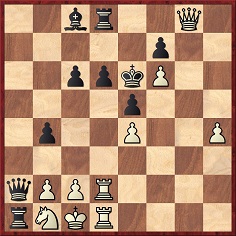
Source: Partidas Magistrales de Roberto Grau, pages 13-16.
(467)
A. Hild – H. Goering
Munich, 23 July 1900
Petroff Defence
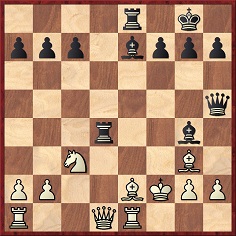
17 Qxd4 Bc5 18 Bxg4 Bxd4+ 19 Kf1 Resigns.
Source: tournament book, page 172.
(751)
Page 11 of the January 1931 BCM quoted from a letter written by Major Claude Chepmell ‘a few years before his death’:
‘A point affecting the young players of my generation, notably Locock and Wainwright: I think we placed the queen’s sacrifice in the “ordinary player’s” hand as an effective weapon and that in so doing we brought the queen’s power into much more correct perspective.
Before the ’80s the queen was over-estimated, and even in ’86 J.H.Blackburne told me that he thought the queen was "too strong for the board”.
Footnotes to games used to mention “Mates or wins the queen” as if they were absolute synonyms. (I think that one edition, Capt. Crawley’s Handbook of Games, had some allusion to this.)
And the queen sacrifice was looked on as something occult, and only permissible to Masters!
By the middle ’90s everybody was sacrificing queens quite joyfully. (I remember Wayte commenting to me on the matter.) I am inclined to claim that change for my generation – though perhaps we were inspired by Howard-Taylor to some extent.
This is scarcely meat for Who’s Who, but may be useful to anyone who is daring enough to write a history of the game from the tactical point of view rather than the antiquarian.’
(1315)
From Alekhine in Europe and Asia by John Donaldson, Nikolay Minev and Yasser Seirawan (Seattle, 1993) here are four little-known queen sacrifices from simultaneous games:
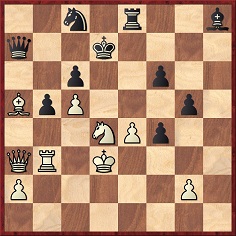
White to move
A. Alekhine v L. Litov, Serpukhov, November 1915
32 Rxb5 Qa6 (if 32...cxb5 then 33 c6 mate) 33 Bc3 Qxa3 34 Rb7+ Kd8 35 Nxc6 mate.
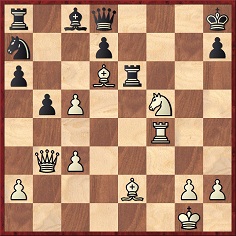
White to move
A. Alekhine v F. Segovia, Buenos Aires, 19 August 1926
26 Qxe6 Nc6 (or 26...dxe6 27 Be5+) 27 Be5+ Nxe5 28 Qxe5+ Resigns.
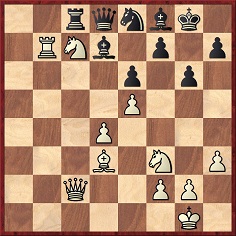
White to move
A. Alekhine v Maurer, Vienna, 4 October 1930
25 Nxe8 Rxc2 26 Nf6+ Kg7 27 Rxd7 Rc1+ 28 Kh2 Qb6 29 Ng5 Kh6 30 Nxf7+ Kg7 31 Nd6+ Kh6 32 Rxh7+ Kg5 33 Nde4+ Kf4 34 Rh4+ Resigns. (Alekhine made heavy weather of the mating net.)
A footnote on page 15 of Kings, Commoners and Knaves observed that whereas the Alekhine book gave ‘33 Nde4+ Kf4 34 Rh4+ 1-0’, according to page 1042 of the October 1930 L’Echiquier Alekhine played the faster 33 Nfe4+.
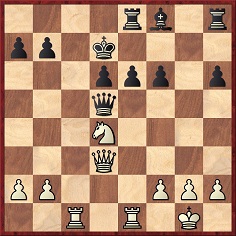
White to move
A. Alekhine v Kohn, Subotica, 28 December 1930
21 Nxe6 Black resigns. (If 21...Qxd3 then 22 Rc7 mate.)
(1970)
A rare case of a master finding himself on the sharp end of Legall’s trap:
V. Sjöberg – Siegbert Tarrasch (simultaneous?)
Skifarp [modern spelling: Skivarp], 24 May 1911
Dutch Defence, Staunton Gambit
1 d4 f5 2 e4 fxe4 3 Nc3 Nf6 4 f3 c5 5 d5 e5 6 dxe6 d5 7 fxe4 d4 8 e5 Nd5 9 Ne4 Bxe6 10 Nf3 Nc6 11 Bd3 Bg4 12 O-O Nxe5
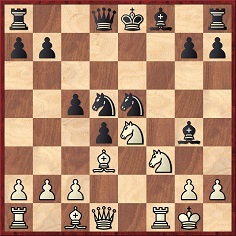
13 Nxe5 Bxd1 14 Bb5+ Ke7 15 Bg5+ Ke6 16 Bxd8 Kxe5 17 Ng5 Bh5 18 Rae1+ Ne3 19 Bc7+ Bd6 20 Ba5 Raf8 21 Rxe3+ dxe3 22 Bc3+ Kd5 23 Bxg7 Bxh2+ 24 Kxh2 Rxf1 25 Bxf1 Rg8 26 Nxh7 Rxg7 27 Nf6+ Ke5 28 Nxh5 Rf7 29 Ng3 Kf4 30 Bd3 a6 31 a4 Rc7 32 b3 Rc6 33 Ne2+ Kg4 34 Kg1 Rf6 35 Be4 Rf7 36 Nc3 b6 37 Bf3+ Kf4 38 Nd5+ Ke5 39 Nxe3 Resigns.
Source: Tidskrift för Schack, September-October 1911, pages 155-156, which contained brief notes by the winner.
(2133)
Stefan Bücker (Nordwalde, Germany) submits a game, lost against his brother, which he published on page 43 of his book Das neue Königsgambit (Stuttgart, 1986):
Stefan Bücker – Peter Bücker
Nordwalde Club Championship, 1975
King’s Gambit Accepted
1 e4 e5 2 f4 exf4 3 Nf3 d5 4 exd5 Nf6 5 Bb5+ c6 6 dxc6 Nxc6 7 d4 Bd6 8 O-O O-O 9 Bxc6 bxc6 10 c4 Bg4 11 Qd3 Qd7 12 Nc3 Rfe8 13 Ne2 g5 14 Nc3 h6 15 a3 Rad8 16 b4 c5 17 Nb5 Bf8 18 d5 Bf5 19 Qd1 a6 20 Nc3 cxb4 21 axb4 Bxb4 22 Bb2 Bc5+ 23 Kh1 Ng4 24 Na4 Ba7 25 Qd2 Re3 26 h3 Rd3 27 Qa5 Ne3 28 Ne5
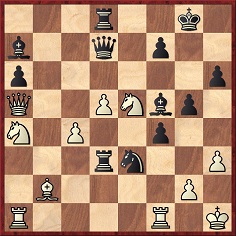
28…Nxf1 29 Rxf1 Be4 30 Kh2 Rg3 31 Nf3 Rb8 32 Qc3 Rxb2 33 Nxb2 g4 34 White resigns.
Our correspondent is the editor of the German-language quarterly Kaissiber, which specializes in openings analysis and historical research. It is one of the most impressive chess magazines we have ever seen.
(2216)
See too C.N. 4826.
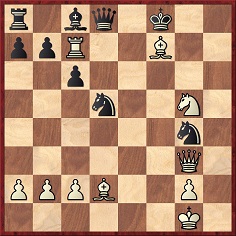
White to move
From a game won by O. Loerbroks in Soest in 1893
1 Qe5 Nxe5 2 Ne6+ Bxe6 3 Bh6 mate.
Source: Deutsche Schachzeitung, March 1893, page 85.
See pages 16-17 of A Chess Omnibus. A footnote mentioned that this was not a forced conclusion, and that the Fritz computer program showed that 1 Nh7+ would have given mate in, at most, seven moves.
An example of how Marshall liked to shock his opponents:
John R. Orton – Frank James Marshall
Montreal, date?
Queen’s Gambit Declined
1 d4 d5 2 c4 e6 3 Nc3 c5 4 e3 Nc6 5 Nf3 Nf6 6 a3 cxd4 7 exd4 dxc4 8 Bxc4 Be7 9 Be3 O-O 10 O-O a6 11 Qc2 b5 12 Bd3 Bb7 13 Rfd1 Rc8 14 d5 exd5 15 Nxd5
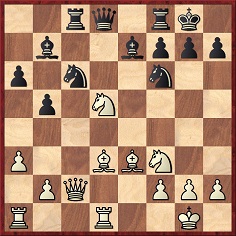
15…Qxd5 (‘Done, no doubt, in a spirit of adventure, which at all times moves the United States champion to place his head in the lion’s mouth. By rights the jaws should have snapped upon him, but he escaped by the skin of his own teeth. Instead of the text, he should have played 15…Nxd5.’) 16 Bxh7+ Nxh7 17 Rxd5 Nb4 18 Qxc8 Rxc8 19 Rd7 Bxf3 20 axb4 Bxb4 21 gxf3 Nf6 22 Ra7 a5 23 Rb7 Rc2 24 Rb1 Nd5 25 Rxb5 Nxe3 26 fxe3 Re2 27 e4 Bd2 28 h3 f6 29 Rf1 Kh7 Drawn.
Source: American Chess Bulletin, February 1920, page 35.
(2256)
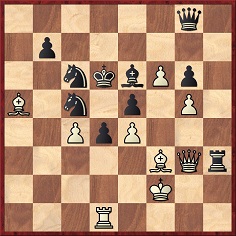
D. Harrwitz-Grosdemange, (Paris?) 1854
1 Rxd4+ Nxd4 2 Qxe5+ Kd7 and White mated in two moves.
Source: BCM, November 1888, page 446.
The temptation, as ever, is to wonder how often this finish would have been published if it had been brought off by Morphy.
(Kingpin, 1998)
Can the beauty of chess moves be defined or classified? For now, just one aspect will be examined: the relative aesthetic value of two forcing lines. We take as an illustration a forgotten game of extreme brevity:
Fraser-N.N.
Occasion?
Centre Counter Game
1 e4 d5 2 e5 d4 3 Bd3 Nd7 4 e6 fxe6 and White mated in three moves.
Source: Revue d’échecs, November 1902, page 40, which indicated that it took the gamelet from the Illustrated London News.

Above is the position after 4…fxe6 5 Qh5+ g6. Is the heavyweight sacrifice 6 Qxg6+ more ‘aesthetically pleasing’ than the restrained 6 Bxg6+ line? A similar question may be asked about the next position:
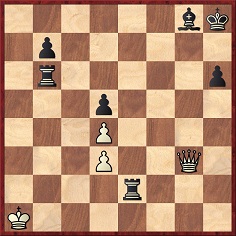
White to move
V.L. Wahltuch-R.C Griffith, Richmond, 1912
In this position (taken from page 364 of the September 1912 BCM) Wahltuch preferred 60 Qg7+ to 60 Qxg8+. Is his choice aesthetically better, perhaps because it is a shorter move and less showy? Or is showy the word to describe 60 Qg7+, because it leaves Black with more redundant material? Or again, might 60 Qxg8+ be favoured for leading to a more refined form of stalemate, the a2 square then being covered only once? Conversely, is it all much of a muchness?
(2257)
Richard Forster has found that the Fraser game was published on page 634 of the Illustrated London News, 24 December 1881, with the following introduction:
‘The vast majority of brief games are by no means brilliant, and there are many brilliant games that are only comparatively brief. Here is an example of the former class, in which the late Dr Fraser, of Edinburgh, played the white pieces:-1 e4 d5 2 e5 d4 3 Bd3 Nd7 4 e6 fxe6 White mates in three moves. This is brief enough to satisfy the most exacting taste for that quality, but there is nothing very new or very brilliant in the mating moves …’
The aesthetics issue is also illustrated by the forgotten game below, which Keres annotated on pages 10-11 of the January 1941 Deutsche Schachzeitung:
Paul Keres – Jānis Viļķins (‘J. Wilkins’)
Correspondence game, 1933
Petroff’s Defence
1 e4 e5 2 Nf3 Nf6 3 Bc4 Nc6 4 d4 exd4 5 O-O Bc5 6 c3 Nxe4 7 Re1 d5 8 Ng5 dxc4 9 Rxe4+ Be6 10 Nxe6 fxe6 11 Qh5+ g6 12 Qxc5 dxc3 13 Nxc3 Qd7 14 Bg5 h6 15 Rd1 Qf7 16 Rf4 Qg8 17 Nb5 Rc8
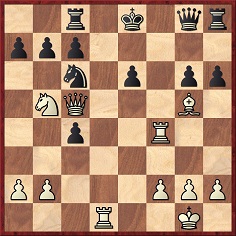
18 Qxc6 bxc6 19 Nxc7+ Rxc7 20 Rd8 mate.
White’s 18th and 19th moves could have been inverted, hence giving a choice of whether to begin with the ‘heavy’ sacrifice.
(2285)
Regarding the identity of Black, see C.N. 5777.
C.N.s 2257 and 2285 (see too pages 144-145 of A Chess Omnibus) discussed ‘the relative aesthetic value of two forcing lines’, i.e. the question of whether it is preferable, in artistic terms, to sacrifice heavily or lightly. Now Neil Brennen (Spring City, PA, USA) quotes to us another illustrative position, from page 12 of Storming the Barricades by Larry Christiansen (London, 2000):
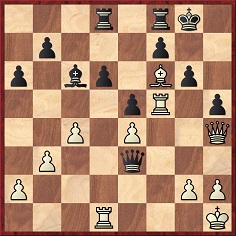
Regarding the Lone Pine tournaments (and this position from the 1977 event in particular) Christiansen wrote:
‘There was some grumbling that the judge for the brilliancy prizes, tournament director Isaac Kashdan, tended to favour quantity over quality. For instance, a simple rook or queen sacrifice would be selected over a more complex piece or pawn sacrifice. I once had a game against Eugene Meyer where I had the choice between sacrificing a rook or queen to deliver mate and chose the queen to grab Kashdan’s attention. Sure enough I received a brilliancy prize for that game, despite competition from games with far more complex but less generous combinations.
I finished this game for “business reasons” with 25 Qxh5 gxh5 26 Rxh5 1-0.’
(3034)
We are always on the look-out for unusual combinations, even if faulty. Here is one:
Leon L. Labatt – Elliott
New Orleans, 1884
King’s Gambit Accepted
1 e4 e5 2 f4 exf4 3 Nf3 g5 4 Bc4 Bg7 5 O-O h6 6 d4 d6 7 g3 Bh3 8 Rf2 c5 9 c3 Nf6 10 gxf4 g4 11 e5 dxe5 12 fxe5 Ne4 13 Bxf7+ Ke7 14 Qb3 Qd7 15 e6 Qc7 16 Nh4 Nxf2 17 Ng6+ Kf6 18 Bf4 Qc6 19 d5 Qa6 20 Nd2 Nc6 21 Kxf2 Qd3
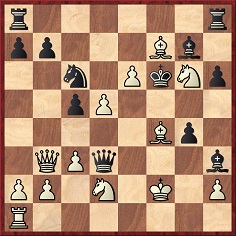
22 Qb5 (‘A very beautiful stroke of play, leading to one of the most curious mating positions that we have ever seen in actual play.’) 22…Qxb5 23 Ne4+ Kf5 24 Ng3+ Kf6 25 Ke3 Resigns.
Source: Brooklyn Chess Chronicle, 15 August 1884, pages 172-173.
The magazine makes no mention of 22…Qxd5, which would have left everything to play for.
(2355)
Andrés Clemente Vázquez – Francis Joseph Lee
Havana, 12 February 1894
Two Knights’ Defence
1 e4 e5 2 Nf3 Nc6 3 Bc4 Nf6 4 d3 Bc5 5 O-O d6 6 Nc3 Bg4 7 Ne2 h6 8 c3 O-O 9 a4 a6 10 b4 Ba7 11 Ng3 Ne7 12 h3 Be6 13 Nh4 g5 14 Qf3 Kg7
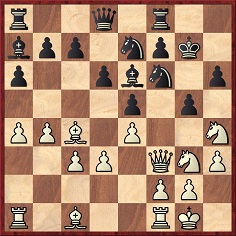
Source: La Stratégie, 15 March 1894, pages 78-79.
(Kingpin, 2000)
Blackburne called the following game the most brilliant and interesting of all his losses in blindfold displays:
Joseph Henry Blackburne (blindfold) – George Beach
Macclesfield, 1900
Evans Gambit Accepted
1 e4 e5 2 Nf3 Nc6 3 Bc4 Bc5 4 b4 Bxb4 5 c3 Ba5 6 d4 exd4 7 O-O dxc3 8 e5 b5 9 Bxb5 c2 10 Qxc2 Nge7 11 Rd1 O-O 12 Nc3 Bb7 13 Ba3 Re8 14 Ng5 g6 15 Nce4 Nd5 16 Rxd5 Nxe5 17 Rxe5 Rxe5 18 Bb2 Rxg5 19 Nf6+
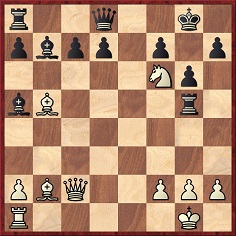
19…Qxf6 20 Bxf6 Rxg2+ 21 Kf1 Rxh2 22 Qb3 Rh1+ 23 Ke2 Re8+ 24 Kd3 Rh3+ 25 Kc2 Rxb3 26 axb3 Bb6 27 Bxd7 Re2+ 28 Kc3 Rxf2 29 White resigns.
Source: BCM, February 1937, page 100.
(2400)
A seldom-seen victory by the late Arthur Dake:
Albert C. Simonson – Arthur William Dake
Milwaukee, 1935 (Section C)
Réti’s Opening
1 Nf3 Nf6 2 g3 b6 3 b3 Bb7 4 Bb2 g6 5 Bg2 Bg7 6 O-O O-O 7 c4 c5 8 Na3 Nc6 9 Nc2 d5 10 cxd5 Qxd5 11 Ne3 Qd7 12 Rc1 Rfd8 13 d3 Rac8 14 Nc4 Qc7 15 Qc2 Qb8 16 Qb1 Qa8 17 Bh3 Rc7 18 Nce5 Ne8 19 Nxf7 Kxf7 20 Ng5+ Kf8 21 Ne6+ Kf7 22 Bxg7 Nxg7 23 Nxc7
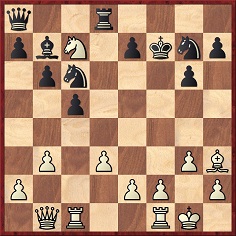
23…Nd4 24 Bg4 Qc8 25 Ne6 Ngxe6 26 e4 h5 27 Bd1 Qd7 28 f4 a5 29 Qb2 Ng7 30 Qg2 Ngf5 31 Qf2 Ng7 32 Qg2 Ndf5 33 Rf3 Qd4+ 34 Kh1 Ne3 35 Qe2 Nxd1 36 Rxd1 Bxe4 37 White resigns.
Source: Year Book of The American Chess Federation, Volume 1, 1935, pages 51-52.
(2415)
A queen sacrifice leads to a double check and a quick mate:
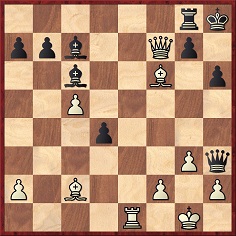
White to move
36 Re4 gxf6 37 Qh7+ Kxh7 38 Re7+ Kh8 39 Rh7 mate.
Below is the full game:
S. Lurie and E. Wagenheim – J. Bastin and O. Bolotow
Riga, 8 and 9 April 1898
Evans Gambit Accepted
1 e4 e5 2 Nf3 Nc6 3 Bc4 Bc5 4 b4 Bxb4 5 c3 Bd6 6 d4 Nf6 7 Bb5 Qe7 8 O-O O-O 9 Re1 h6 10 c4 Bb4 11 Re2 Nxd4 12 Nxd4 exd4 13 e5 Nh7 14 Qxd4 c6 15 Ba4 d6 16 Bb2 dxe5 17 Rxe5 Qd6 18 Qe3 Nf6 19 c5 Qd8 20 Qf4 Ba5 21 Na3 Bc7 22 Nc4 Nd5 23 Qg3 f6 24 Rxd5 cxd5 25 Nd6 Qe7 26 Bb3 Qe6 27 Rd1 Qe2 28 Bc3 Kh8 29 Qg6 Qg4 30 Nf7+ Rxf7 31 Qxf7 Bd7 32 Bc2 Bc6 33 Bxf6 d4 34 g3 Rg8 35 Re1 Qh3 36 Re4 gxf6 37 Qh7+ Kxh7 38 Re7+ Kh8 39 Rh7 mate
Source: Baltische Schachblätter, Heft 11, 1908, pages 17-19.
(3137)
The game-score below, from a simultaneous display, appeared on page 154 of Schachjahrbuch 1914 I. Teil by L. Bachmann (Ansbach, 1914), but we wonder if it is correct, given that, at move 23, White could have forced mate with a standard queen sacrifice.
Joseph Henry Blackburne – E.S.
St Petersburg, 9 May 1914
Vienna Game
1 e4 e5 2 Nc3 Nf6 3 Bc4 Nc6 4 d3 Be7 5 f4 exf4 6 Bxf4 Na5 7 Nf3 Nxc4 8 dxc4 d6 9 O-O Bg4 10 Qe1 Nh5 11 Be3 O-O 12 Nd5 a6 13 Rd1 c6 14 Bb6 Qd7 15 Ne3 Bxf3 16 Rxf3 Qe6 17 Nf5 Rae8 18 Bd4 Nf6 19 Qg3 g6 20 Nxe7+ Qxe7 21 Bxf6 Qxe4 22 Qh3 Re6
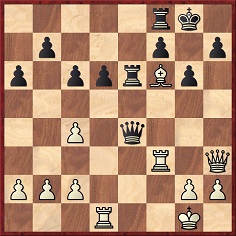
23 Bc3 f6 24 Re1 Resigns.
(2562)
A casual game featuring an unusual queen sacrifice:
Johann Behting – Robert Behting
Riga, 1895
Petroff’s Defence
1 e4 e5 2 Nf3 Nf6 3 d4 Nxe4 4 Bd3 d5 5 Nxe5 Nd6 6 O-O Be6 7 b3 g6 8 Re1 Bg7 9 c4 O-O 10 Nc3 dxc4 11 bxc4 Nd7 12 Qb3 Bxe5 13 dxe5 Nc5 14 Qc2 Nxd3 15 Qxd3 Nf5 16 Nd5 Kg7 17 g4 Nh6 18 Qf3 Ng8 19 Nf6 Qd4 20 Be3 Qxc4 21 Rac1 Qa4 22 Nxg8 Kxg8 23 h3 f5 24 exf6 Rf7 25 Qxb7 Rd8 26 Rxc7 Bd5
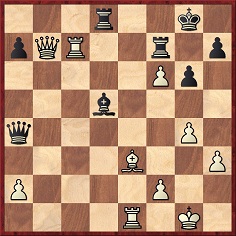
27 Rxf7 Bxb7 28 Rg7+ Kh8 29 Rxb7 Qa5 30 Rc1 h5 31 Rxa7 Qe5 32 Bd2 Resigns.
Source: Rigasche Rundschau, 11 August 1900 (new style).
(2719)
J.L. Younkman – E.A. Coleman
Correspondence game (Western Australia), 1915
King’s Gambit Accepted
1 e4 e5 2 f4 exf4 3 Nf3 g5 4 Bc4 Bg7 5 O-O d6 6 d4 h6 7 c3 Qe7 8 Na3 a6 9 Nc2 Be6 10 Bd3 Nf6 11 b3 Nbd7 12 h3 Nh5 13 Re1 O-O 14 Ba3 c5 15 Qd2 g4 16 hxg4 Bxg4 17 Qf2 Bf6 18 Rad1 Rfe8 19 b4 cxd4 20 cxd4 b5 21 Bb2 Ng3 22 Ra1 Bxf3 23 Qxf3 Bg5 24 a4 bxa4 25 Rxa4 Nf6 26 e5 h5 27 Ne3 Qd7 28 Ra5 dxe5 29 Nc4 Ng4 30 Nb6 Qe7 31 Nxa8 Bh6 32 Raxe5 Qh4 33 Rxe8+ Bf8
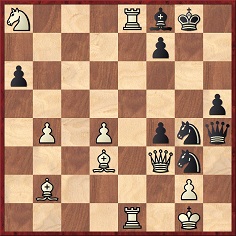
34 Qxg4+ hxg4 35 Nc7 Qf6 36 Rxf8+ Kxf8 37 Re8+ Kg7 38 Re6 Qh4 39 d5+ f6 40 Bxf6+ Qxf6 41 Ne8+ Resigns.
Source: BCM, September 1915, pages 323-324.
(2744)
One of the few players to have boasted of producing an ‘immortal’ game was Gerald Abrahams, in two of his books. Pages 246-247 of Not Only Chess (London, 1974) and page 136 of Brilliance in Chess (London, 1977) had the heading ‘An Immortal’, plus almost identical notes to his well-known game against (R.S.?) Thynne, ‘Liverpool, 1930’:
1 d4 Nf6 2 c4 e6 3 Nc3 d5 4 Bg5 Be7 5 e3 Nbd7 6 Nf3 O-O 7 Rc1 c6 8 Qc2 Re8 9 Bd3 dxc4 10 Bxc4 Nd5 11 Ne4 Bxg5 12 Nexg5 N5f6 13 Kf1 h6 14 h4 hxg5 15 hxg5 e5 16 gxf6 Qxf6 17 Qh7+ Kf8 18 Nh4 Nb6 19 dxe5 Qxe5 (‘In answer to 19…Qxe5 I had been saving something up. In fact I’d invited an old gentleman who was pottering towards the door, to stay, because in a few minutes I’d have a good move for him to see.’)
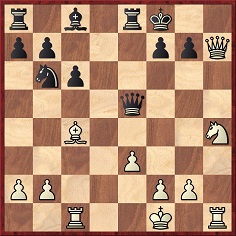
20 Qg8+ (‘And the rest is history.’) 20…Ke7 (‘If 20…Kxg8 21 Ng6 forces mate.’) 21 Qxf7+ Kd8 22 Ng6 Qxb2 23 Rd1+ Bd7 24 Qxe8+ Resigns.
Abrahams also gave ‘Liverpool, 1930’ when presenting his 20th move (‘one of very few moves known to the Author which merits an exclamation mark although the main variation is only two moves deep’) on page 43 of The Chess Mind (Harmondsworth, 1960), whereas on page 39 of the original hardback edition (London, 1951) no players’ names or occasion were specified.
But Abrahams was not always the most rigorous author for dates and other ‘details’, so is ‘Liverpool, 1930’ correct? When Chernev gave the score on pages 537-538 of 1000 Best Short Games of Chess he put ‘Liverpool, 1929’, whereas the two Informant books on middle-game combinations (pages 191 and 284 respectively) had ‘Liverpool, 1932’. On page 28 of The Brilliant Touch (London, 1950) Walter Korn stated ‘Liverpool C.C. Championship, 1936’.
(3158)
David McAlister (Hillsborough, Northern Ireland) reports that Gerald Abrahams’ game against Thynne was published in the Belfast News-Letter of 1 February 1934. Our correspondent comments:
‘While it does not help with time and place, the date of publication can at least rule out Korn’s attribution. Also, the initials R.S. are given for Thynne.’
We now seek pre-1934 cases of the game being published.
(3167)
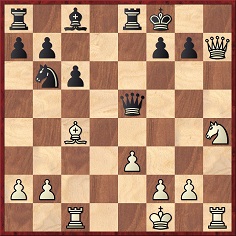
White to move
We have not yet quoted C.J.S. Purdy on the game. He annotated it on pages 315-316 of the Australasian Chess Review, 12 November 1936 with this introduction:
‘We all enjoy bombshell moves. The 20th move in this game makes a loud enough explosion for anybody. Abrahams specializes in bombing.’
Purdy gave 20 Qg8+ three exclamation marks.
(11959)
Addition on 25 May 2025:
David McAlister has now found the game-score on page 5 of the 19 July 1930 edition of the Northern Whig and Belfast Post:

How early in a game has a player sacrificed his queen? Below is a case at move three:
Ressel – Piperno
New York, 1933 or 1934
Irregular Opening
1 f3 e6 2 h4 Bd6 3 Rh3 Qxh4+ 4 g3 Bxg3+ 5 Rxg3 Qxg3 mate.
4…Qxg3+ would have given a five-move game with two consecutive queen sacrifices.
In venturing to publish this game we are at least in the company of the American Chess Bulletin (January 1934, page 10), which received the moves from an eminent eye witness, F.J. Marshall.
(3382)
Alan O’Brien (Mitcham, England) draws attention to this position from L. Kavalek v L. Polugayevsky, Havana Olympiad, 1966:
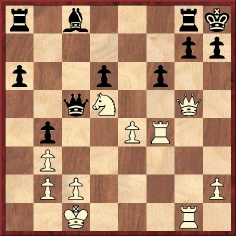
The continuation was 26 Qg6 Qf2, and our correspondent points out that on page 160 of his book The Sicilian Labyrinth, volume 1 (Oxford, 1991) Polugayevsky wrote:
‘A very rare instance from a practical game where both queens simultaneously sacrifice themselves. Had there been a prize not for the most brilliant game, but for the most brilliant move, this “dying” duet of the queens would have had every chance of winning it ...’
The game was eventually drawn.
We recall only one other such occurrence, given in C.N. 2197:
A. Rhode – Willi Schlage
Correspondence game, 1917
Two Knights’ Defence
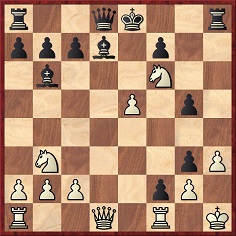
21…Qxf6 22 Qxd7+ (Schlage: ‘The only move. These successive queen sacrifices, which are also the first moves by both queens, are most likely unique in chess literature.’ 22 exf6 is refuted by 22…Rxh3+ and 23…Bc6+.) 22…Kxd7 23 exf6 Rag8 24 Rfd1+ Ke6 25 Nd2 g4 26 Nf1 gxh3 27 Rd3 hxg2+ 28 Kxg2
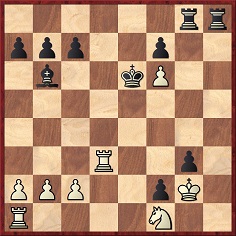
28…Rh1 29 White resigns.
Source: Deutsche Schachzeitung, May 1917, pages 106-107.
Below are some other instances of unusual queen offers, starting with a game (R. Swiderski v H. Caro, Barmen, 1905) in which both players gave up their queens, although not ‘simultaneously’ or ‘successively’. It was given in C.N. 751 and on pages 44-45 of Chess Explorations:
1 c4 e5 2 Nc3 Nf6 3 g3 Bc5 4 Bg2 O-O 5 e3 Nc6 6 Nge2 Re8 7 O-O e4 8 Qc2 Qe7 9 Nf4 Nb4 10 Qb1 c6 11 a3 Na6 12 d4 exd3 13 Qxd3 d6 14 b4 Bb6 15 Bb2 Ng4 16 Ne4 Ne5 17 Qc3 f6 18 Rad1 Bc7 19 h3 Bf5 20 g4 Nxg4 21 Ng3 Nh6 22 Kh1 Rad8 23 Rg1 Bg6 24 Nxg6 hxg6 25 Be4 Qe6 26 Rg2 Qxh3+ 27 Rh2 Qg4 28 f3 Qxg3 29 Rg1
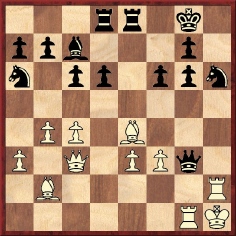
29...Qxh2+ 30 Kxh2 d5+ 31 f4 Rxe4 32 cxd5 Kh7 33 dxc6 Nf5 34 Bc1 Rde8 35 b5 Nxe3 36 Rh1 Bxf4+ 37 Kg1+ Bh6 38 bxa6 Rg4+ 39 Kf2 Rf4+ 40 Kg3 Nf5+ 41 Kg2 Re2+ 42 Kg1 Rg4+ 43 Kf1 Ng3+
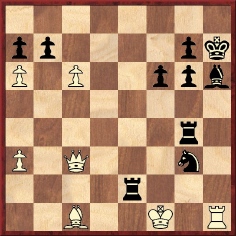
44 Qxg3 Rxg3 45 axb7 Rgg2 46 Rxh6+ gxh6 47 b8Q Rgf2+ 48 Kg1 Rf5 49 Qxa7+ Kg8 50 Bxh6 Re1+ 51 Kg2 Re2+ 52 Kg3 Resigns.
Two consecutive queen sacrifices (by promotion) occurred in K. Gilg v K. Lamprecht, Karbitz, 1924 (see pages 11-12 of Kings, Commoners and Knaves):
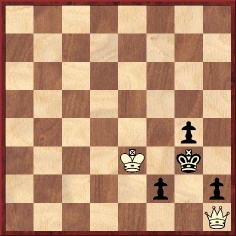
Black played 68...f1(Q) 69 Qxf1 h1(Q) 70 Qxh1 Stalemate.
Source: Österreichische Schachrundschau, September 1924, page 270.
The next position arose in the game C.W. v Kostrovitsky, St Petersburg, 1893 (?), as given on pages 15-16 of A Chess Omnibus:
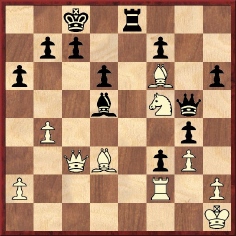
Black offered his queen on three consecutive moves: 1...Qxf6 2 Qc1 Qb2 3 Qf1 Qxf2 4 Qxf2 Re1+ 5 Qxe1 f2+ and mate in two.
Source: Deutsche Schachezeitung, May 1893, page 148.
A game in which ‘White sacrifices both queens within three moves and wins’ appeared on page 105 of Mastering Tactical Ideas by Nikolay Minev (Seattle, 2000), headed ‘Keller – Jaser, corre. 1976/78’:
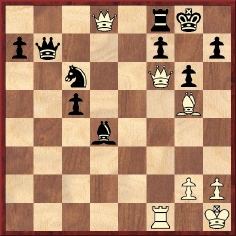
1 Q8xd4 Nxd4 2 Bh6 Ne6 3 Qxe6 and wins.
The final position comes from a 2002-2003 league match in London between L. Trent and D. Tan:
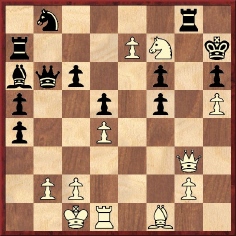
The last move of the game was 27 e8(Q), and on page 21 of issue 37 of Kingpin Jonathan Rogers wrote:
‘A novel situation, as far as I know. Has anyone before seen a serious game where one side has two queens, both en prise and unprotected even, to the same enemy piece, with each queen being able to deliver mate in one upon the capture of the other?’
Yossy Fallakh (Or-Yehuda, Israel) recalls the game between L. Pachman and J. Timman, Geneva, 1977:
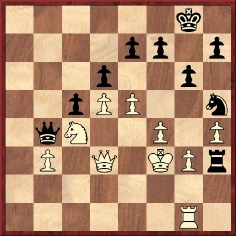
Play went 40...Qe1 41 Qxg6+, and the game was eventually drawn. Pachman annotated the conclusion on pages 310-311 of the July 1977 BCM, and it should be noted that some modern sources misdate the game 1978.
(4861)
From page 22 of Relax with Chess by Fred Reinfeld (New York, 1948):
‘It was that exuberant phrase-maker and paradox-monger Dr Tartakower who once remarked that a pawn sacrifice requires more skill than does a queen sacrifice. The reason? Sacrificing the queen calls for exact calculation of a quick finish. The pawn sacrifice, on the other hand, involves an intuitive flair possessed as a rule only by the great masters.’
Where did Tartakower make such a remark?
From page v of Chess Brilliants by I.O. Howard Taylor (London, 1869):
‘Position is everything. To give up a pawn is sometimes a bolder venture than to abandon a queen.’
(6116)
‘A pawn sacrifice may be more brilliant than a queen sacrifice ...’
Source: Australasian Chess Review, November 1936, page 314, from the introduction to Reshevsky v Vidmar, Nottingham, 1936.
Below is the text of C.N. 3048 (see page 54 of Chess Facts and Fables), concerning a familiar miniature:
Lukomsky – Pobedin
Moscow, 1929
Queen’s Fianchetto Defence1 d4 Nf6 2 c4 b6 3 Nc3 e6 4 e4 Bb4 5 e5 Ne4 6 Qg4 Nxc3 7 bxc3 Bxc3+ 8 Kd1 Kf8 9 Rb1 Nc6 10 Ba3+ Kg8 11 Rb3 Bxd4
12 Qxg7+ Kxg7 13 Rg3+ Resigns.
Some sources (including the Wiener Schachzeitung, June 1929, pages 184-185) gave Pobedin’s name as ‘Podebin’.
The game illustrates how prominent masters may differ in their appreciation of games and positions. Annotating the miniature on pages 122-124 of the June 1930 Ajedrez, Tartakower gave White’s 12th move two exclamation marks and referred to ‘this splendid queen sacrifice’. On page 178 of 1000 Best Short Games of Chess (New York, 1955) Irving Chernev reported that Marshall ‘was fond of this game’. In contrast, Réti found the combination ‘banal and uninteresting’. He was writing in Morgenzeitung, and his notes were reproduced on pages 218-219 of the July 1929 Deutsche Schachzeitung. See also page 5 of Réti’s Best Games of Chess by H. Golombek (London, 1954).
For ease of reference, we add here the Tartakower and Réti texts:
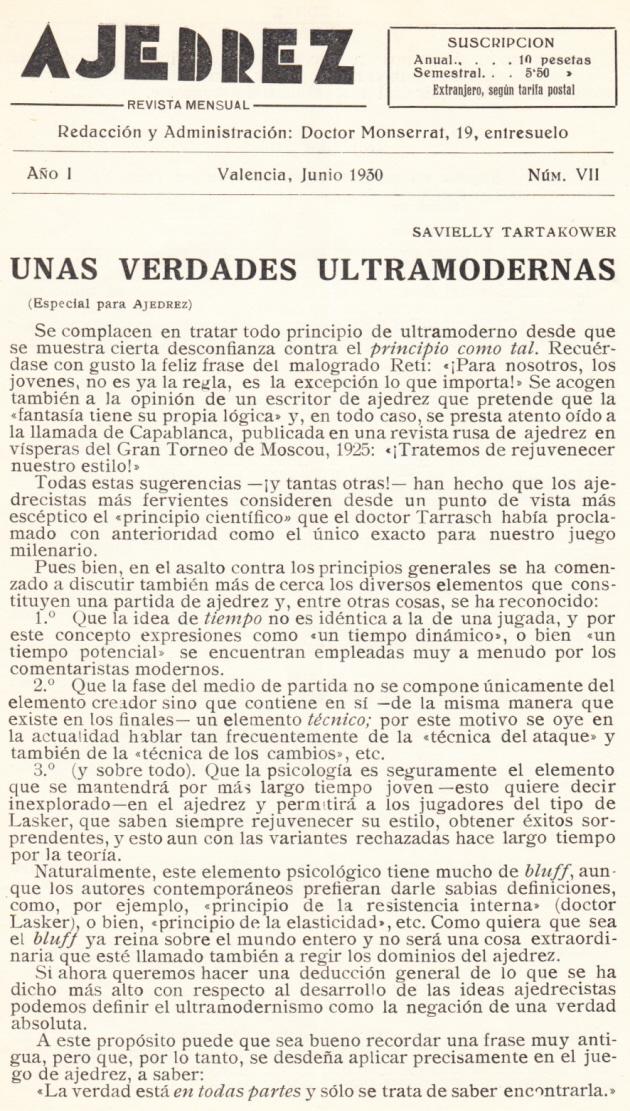
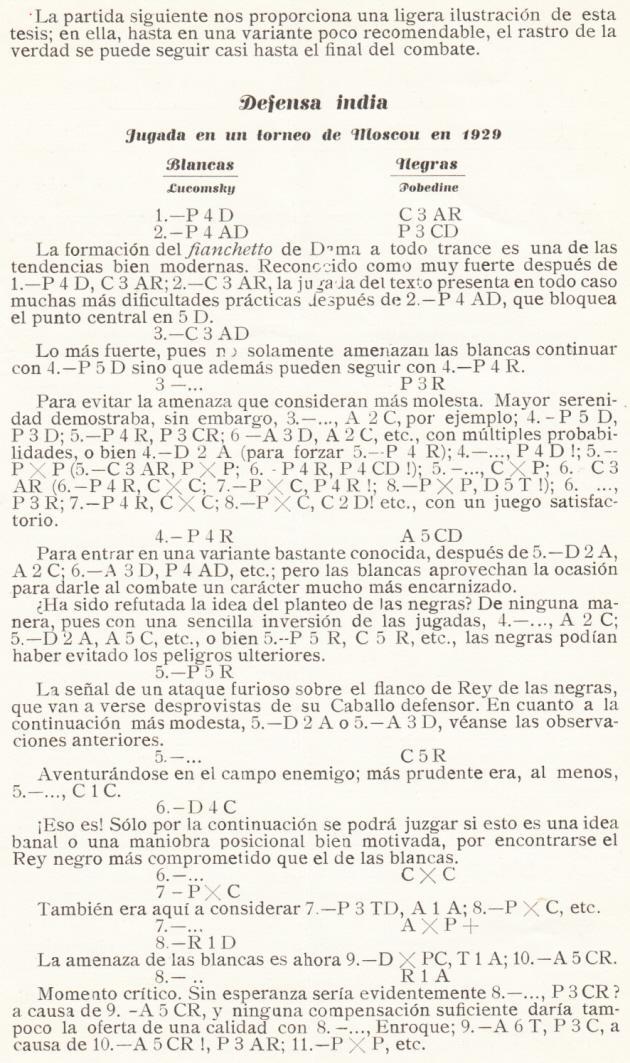
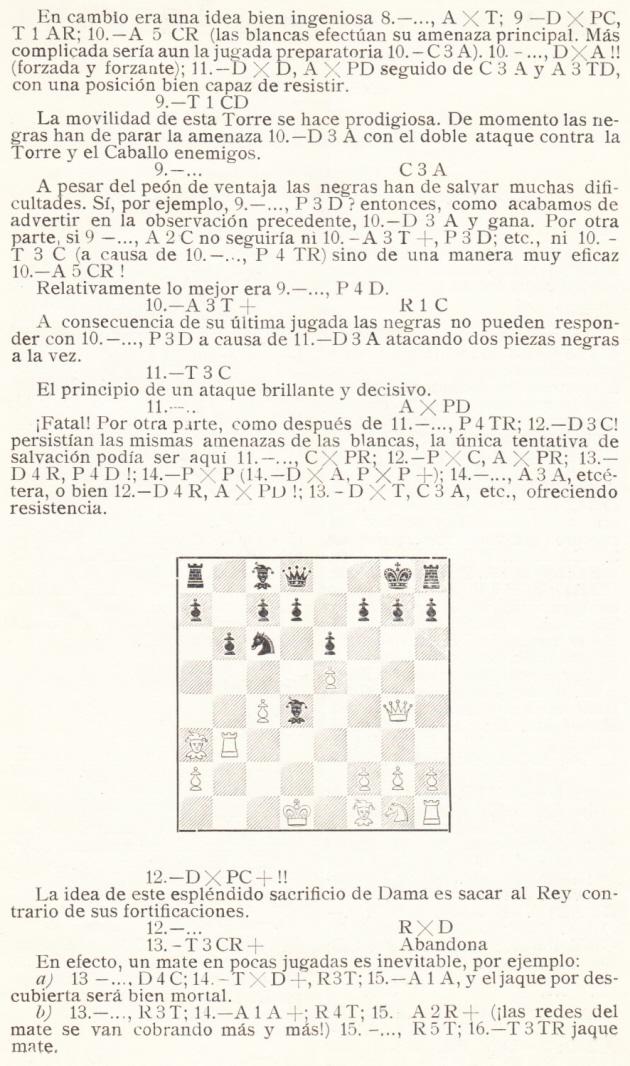
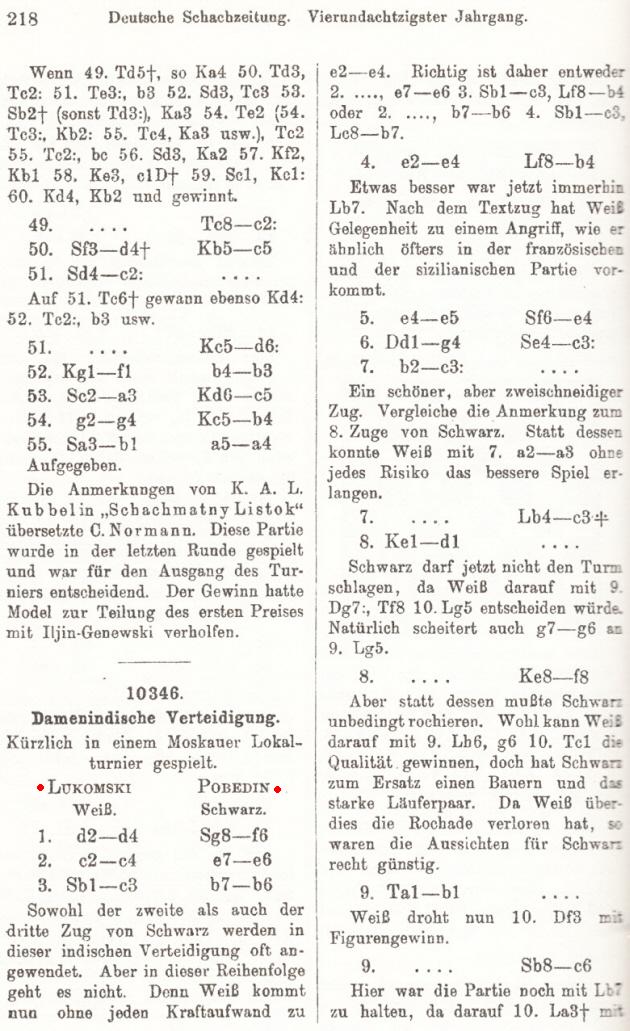
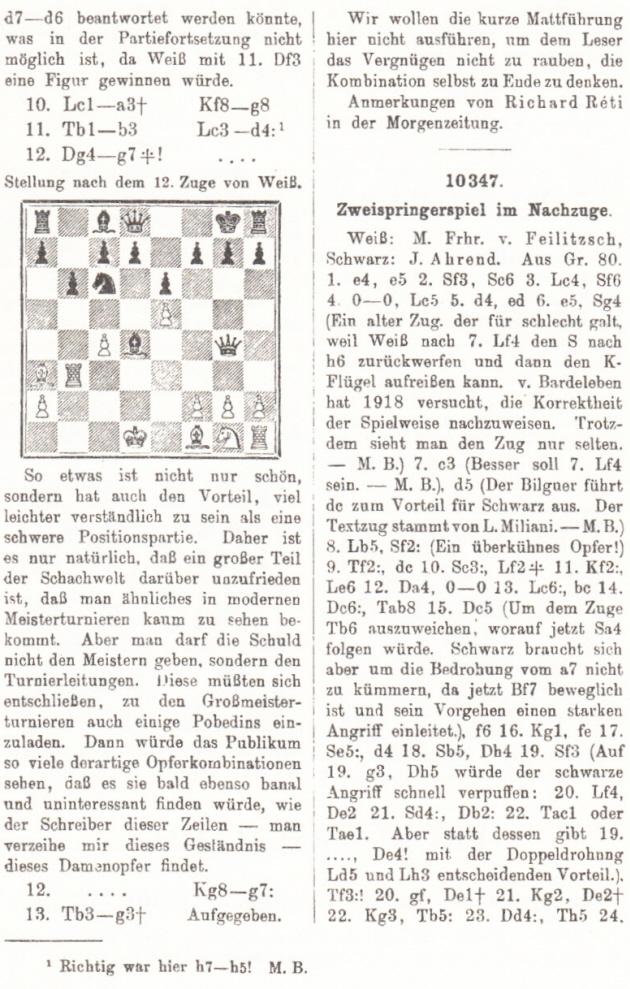
Finally, the text on page 5 of Golombek’s book on Réti:
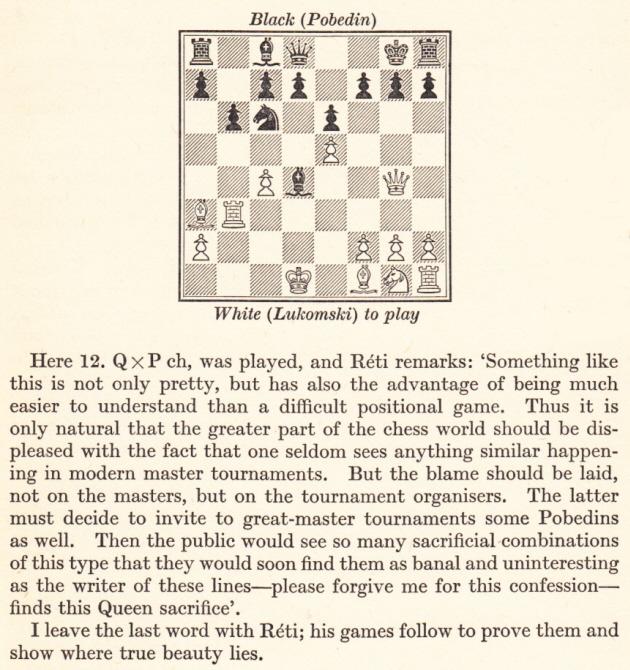
In some databases White was named as Lugowski or Lukowski. What is the earliest known publication of the game in a Soviet source?
Salo Landau – N.N.
Simultaneous display, Dordrecht, 29 February 1928
Four Knights’ Game
1 Nf3 Nf6 2 b3 Nc6 3 Nc3 e5 4 e4 Bb4 5 Nd5 Nxe4 6 Qe2 f5 7 Nxb4 Nxb4 8 d3 Nf6 9 Qxe5+ Kf7 10 Ng5+ Kg6 11 Qg3 Nh5 12 Qh4 h6 13 Nf3 Nxc2+ 14 Kd1 Nxa1
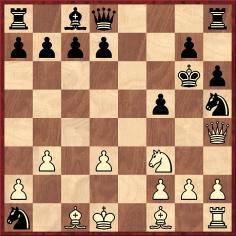
15 Qxh5+ Kxh5 16 Ne5 g5 17 Be2+ g4 18 h3 Qh4 19 hxg4+ fxg4 20 Bxg4 mate.
Source: page 74 of Combinaties uit de Schaakpartij by Lodewijk Prins (The Hague, 1935):
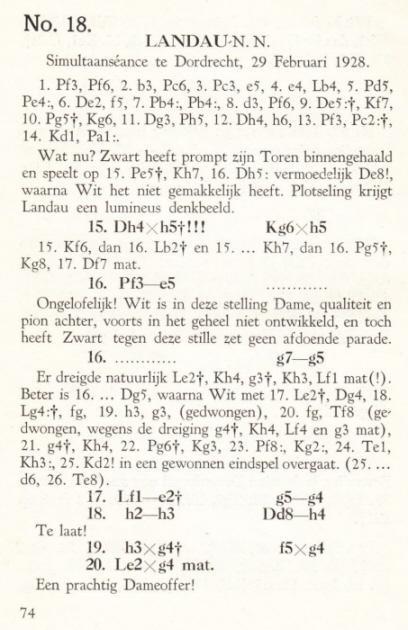
A curiosity is the Legall queen offer when the opponent has castled on the queen’s side:
O. Prochazka (Dornachbrugg) – K. v. Wattenwil and H. Geiler
(Geneva)
49th Swiss correspondence tournament
Centre Counter-Game
1 e4 d5 2 exd5 Qxd5 3 Nc3 Qa5 4 d4 e5 5 dxe5 Bb4 6 Nf3 Nc6 7 Bd3 Bxc3+ 8 bxc3 Bg4 9 O-O O-O-O 10 Bf4 Nge7 11 h3 Bh5 12 Rb1 Ng6 13 Bh2 Ngxe5
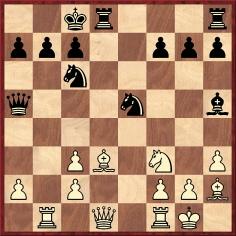
14 Nxe5 Qxe5 15 g4 Qg5 16 f4 Qc5+ 17 Kh1 Bg6 18 f5 Qxc3 19 Qf3 Resigns.
Source: Schweizerische Schachzeitung, November-December 1918, pages 141-142:
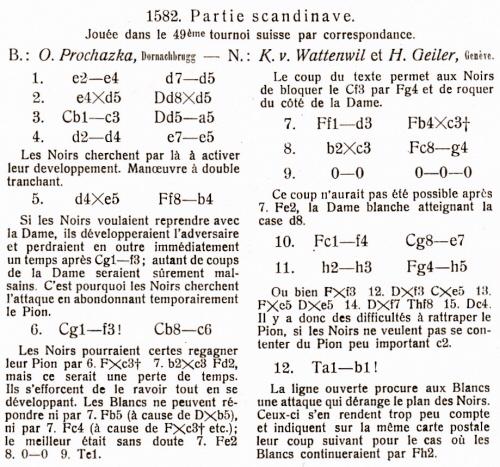
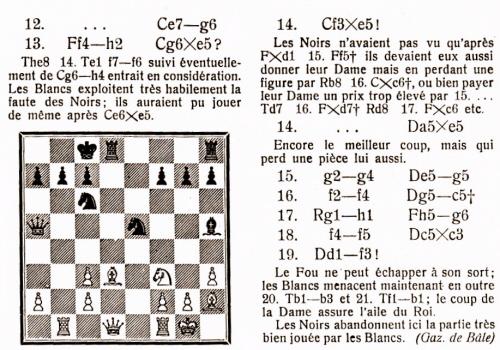
A database search provides these further specimens of the Legall queen offer after the opponent has castled on the queen’s side:
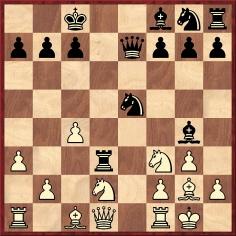
Ludwig Herrmann v Max Eisinger, Hamburg, 1937: 11 Nxe5
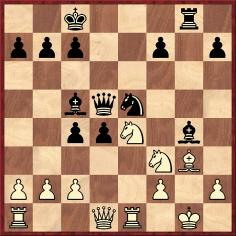
Erwin L’Ami v Mark Smits, Utrecht, 1999: 18 Nxe5
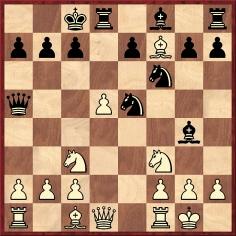
Davorin Komljenović v Isaura Sanjuan Morigosa, Dos Hermanas, 2002: 10 Nxe5
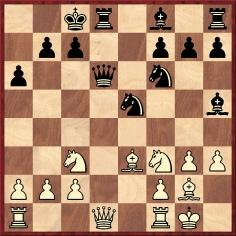
Erik van den Doel v Sergei Tiviakov, Leeuwarden, 2005: 12 Nxe5
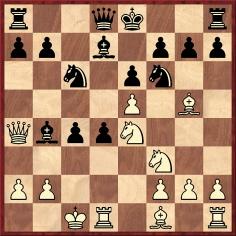
Vassily Ivanchuk v Liviu-Dieter Nisipeanu, Foros, 2007: 10...Nxe4.
The penultimate game was a short draw, and the other four were won by White. Herrmann annotated his game against Eisinger on pages 194-195 of Deutsche Schachblätter, 1 July 1937.
Eduardo Bauzá Mercére (New York, NY, USA) has found this game on page 7 of La Nación, 31 August 1914:
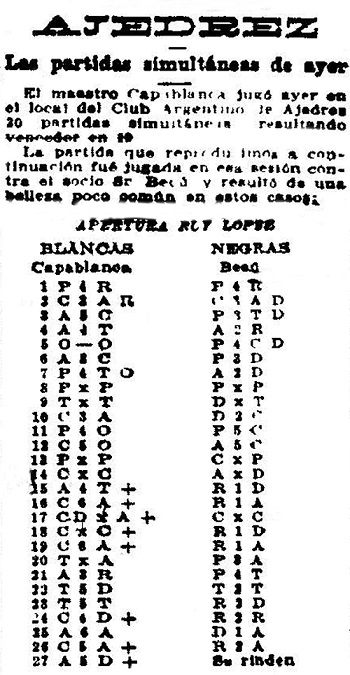
Our correspondent believes that Black was Teodoro Becú, who was mentioned in, for instance, a crosstable on page 115 of the October-December 1909 Revista del Club Argentino de Ajedrez.
José Raúl Capablanca – [Teodoro] Becú
Buenos Aires, 30 August 1914
Ruy López
1 e4 e5 2 Nf3 Nc6 3 Bb5 a6 4 Ba4 Be7 5 O-O b5 6 Bb3 d6 7 a4 Bd7 8 axb5 axb5 9 Rxa8 Qxa8 10 Nc3 Qb7 11 d4 b4 12 Nd5 Bg4 13 dxe5 Nxe5
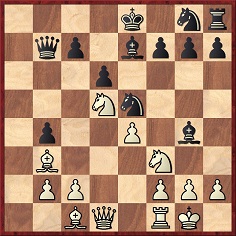
14 Nxe5 Bxd1 15 Ba4+ Kd8 16 Nc6+ Kc8 17 Ndxe7+ Nxe7 18 Nxe7+ Kd8 19 Nc6+ Kc8 20 Rxd1 f6 21 Be3 h5
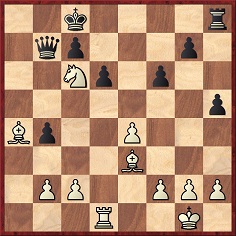
22 Rd5 Rh7 23 Ra5 Kd7 24 Nd4+ Ke7 25 Bc6 Qc8 26 Nf5+ Kf7 27 Bd5+ Resigns.
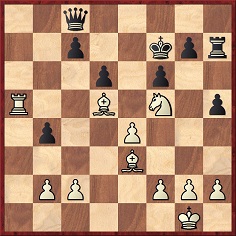
An unusual, if straightforward, queen offer occurred in this game between Bodenstein and von Scheve in the Winterturnier der Berliner Schachgesellschaft which was published on pages 6-7 of the Schachjahrbuch für 1899 by Ludwig Bachmann (Ansbach, 1900):
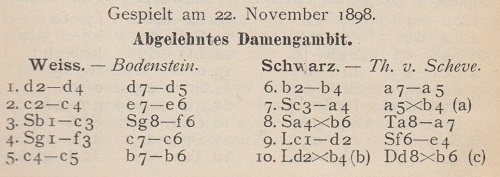
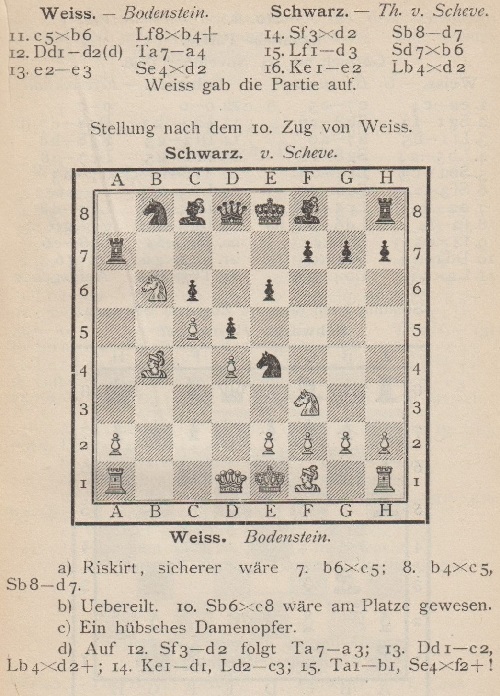
1 d4 d5 2 c4 e6 3 Nc3 Nf6 4 Nf3 c6 5 c5 b6 6 b4 a5 7 Na4 axb4 8 Nxb6 Ra7 9 Bd2 Ne4 10 Bxb4 Qxb6 11 cxb6 Bxb4+ 12 Qd2 Ra4 13 e3 Nxd2 14 Nxd2 Nd7 15 Bd3 Nxb6 16 Ke2 Bxd2 and wins.
Annotating the game on pages 154-155 of Der Schachfreund, December 1898, von Scheve indicated that play continued a little after 16...Bxd2: ‘und Weiss gab nach einigen weiteren Zügen das völlig aussichtslose Spiel auf’.
(10920)
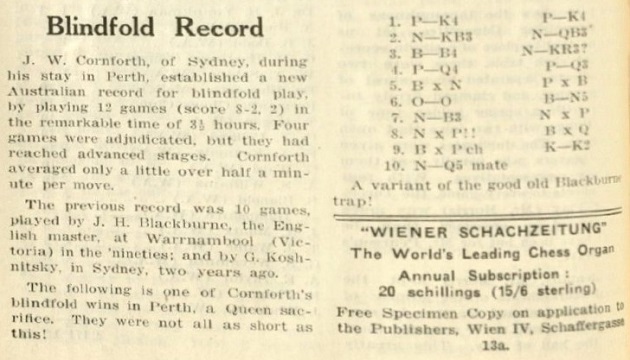
Australasian Chess Review, 27 February 1937, page 26
1 e4 e5 2 Nf3 Nc6 3 Bc4 Nh6 4 d4 d6 5 Bxh6 gxh6 6 O-O Bg4 7 Nc3 Nxd4 8 Nxe5 Bxd1 9 Bxf7+ Ke7 10 Nd5 mate.
(11160)
Eduardo Bauzá Mercére has sent three forgotten games with a common theme:
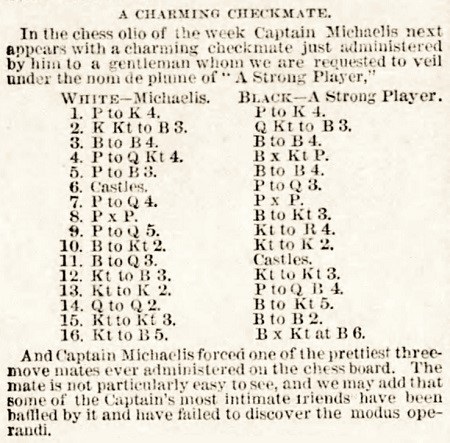
Philadelphia Times, 15 October 1882, page 8
Michaelis v N.N.: 1 e4 e5 2 Nf3 Nc6 3 Bc4 Bc5 4 b4 Bxb4 5 c3 Bc5 6 O-O d6 7 d4 exd4 8 cxd4 Bb6 9 d5 Na5 10 Bb2 Ne7 11 Bd3 O-O 12 Nc3 Ng6 13 Ne2 c5 14 Qd2 Bg4 15 Ng3 Bc7 16 Nf5 Bxf3
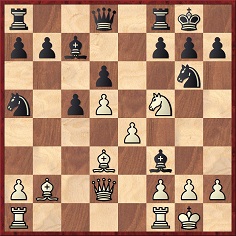
White gave mate in three moves.
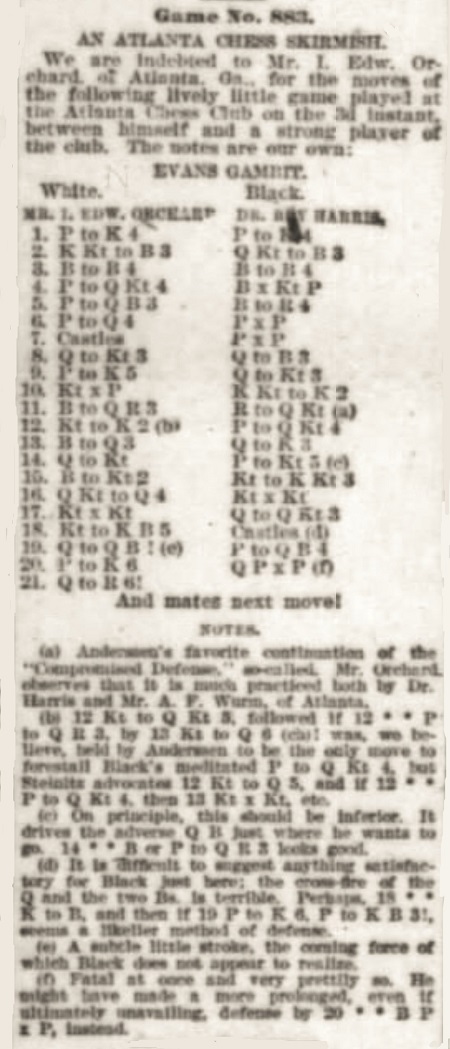
New Orleans Times-Democrat, 18 December 1892, page 19
Orchard v Harris: 1 e4 e5 2 Nf3 Nc6 3 Bc4 Bc5 4 b4 Bxb4 5 c3 Ba5 6 d4 exd4 7 O-O dxc3 8 Qb3 Qf6 9 e5 Qg6 10 Nxc3 Nge7 11 Ba3 Rb8 12 Ne2 b5 13 Bd3 Qe6 14 Qb1 b4 15 Bb2 Ng6 16 Ned4 Nxd4 17 Nxd4 Qb6 18 Nf5 O-O 19 Qc1 c5 20 e6 dxe6
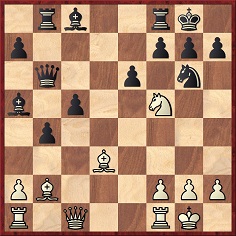
21 Qh6 and mate next move.
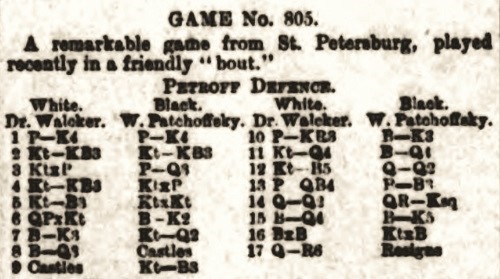
Reading Observer, 1 April 1911, page 7
Walcker v Patchoffsky: 1 e4 e5 2 Nf3 Nf6 3 Nxe5 d6 4 Nf3 Nxe4 5 Nc3 Nxc3 6 dxc3 Be7 7 Be3 Nd7 8 Bd3 O-O 9 O-O Nf6 10 h3 Be6 11 Nd4 Bd5 12 Nf5 Qd7 13 c4 Bc6 14 Qd2 Rae8 15 Bd4 Be4 16 Bxe4 Nxe4
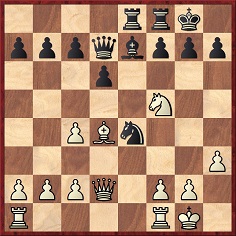
17 Qh6 Resigns.
We add that the last game was published on pages 79-80 of the March 1911 Deutsche Schachzeitung with a precise date, a Russian source and different spellings/transliterations of the players’ names (Walker v Paschkowski):
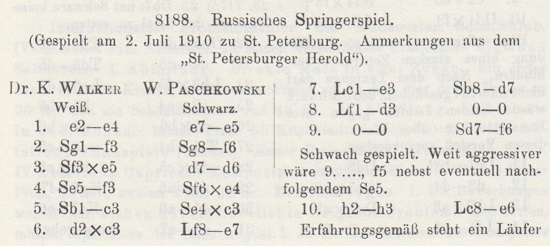
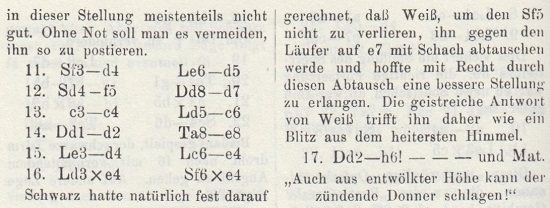
The Qh6 motif is discussed in chapter 18 of L’art de faire mat/The Art of the Checkmate by Georges Renaud and Victor Kahn (various editions).
(11356)
From Richard Forster:
‘When chess.com presented a list of the ten most spectacular chess moves of all time in September 2020, first place went to Shirov’s famous ...Bh3 move against Topalov. However, second place was taken by a virtually unknown specimen:
White played 1 Qc7, and Black resigned after 1...Rdxc7 2 Re8+.
It was pointed out that White had other winning moves, with Stockfish listing the spectacular 1 Qc7 only in about fifth position.
A more interesting question concerns the circumstances and provenance of the ending. Chess.com only wrote “Meier was White against Muller in 1994”, which invited some speculation in the comments section about the identities of the players and the authenticity of the game. Elsewhere on the Internet, “Germany” can be found added as the country, but the origins of the game seem to remain a mystery.
Most likely, the ending was picked up by the chess.com team (directly or indirectly) from John Emms’ controversial 2000 book The Most Amazing Chess Moves of All Time, which had heavily relied on previous work by Tim Krabbé and others with scant acknowledgement (see item 70 on one of Krabbé’s webpages). Emms gave the caption to puzzle 178 as “R. Meier – S. Müller, Switzerland 1994”. As already pointed out in my Late Knight column no. 28 at Chesscafe.com (“Amazing?”), August 2000, the source will have been my earlier Late Knight column no. 2 of June 1998 (“Alpine Accounting”), where I gave the whole game and specified that it was played between René Meier and Stefan Müller in Thun, Switzerland in 1994.
Here is the full score with all the players’ details and the original source:
René Meier (Sihlfeld) – Stefan Müller (Thun), Thun, 7 May 1994. 1 Nf3 c5 2 g3 Nc6 3 Bg2 g6 4 d3 Bg7 5 e4 e6 6 O-O Nge7 7 Nbd2 O-O 8 Re1 d5 9 c3 b6 10 Nf1 Ba6 11 e5 Rc8 12 Bf4 b5 13 a3 Qb6 14 Qd2 Rfd8 15 Bh6 Bh8 16 Qf4 Rd7 17 Ne3 d4 18 Ng5 Nf5 19 Nxf5 exf5 20 e6 fxe6 21 Rxe6 Bb7 22 Rae1 Qd8 23 Qc7 Rdxc7 24 Re8+ Resigns.
The game was played in round five on the seventh and last board of a team match in the second class (“2. Bundesliga”) of the Swiss workers’ Chess Union league (“Gruppenmeisterschaft”). It first appeared in print with a few annotations by the winner in the Schweizerisches Schach-Magazin, no. 6, June 1994, page 189.
A curious twist was added in KARL, no. 3/2023, page 59, when Michael Ehn and Ernst Strouhal gave the ending as “the most spectacular queen sacrifice of all time”, attributing it to “Smith-Walls, USA 1993” without any further indication of their source.
Here for the record is the 1994 publication of the Meier v Müller game:’

(11975)
See too the many queen sacrifices in various classic games discussed in our feature articles.
Latest update: 25 May 2025.
To the Chess Notes main page.
To the Archives for other feature articles.
Copyright: Edward Winter. All rights reserved.